人教版(2019)选择性必修第三册Unit 1 Art Using Language 1 课件(共19张PPT,内镶嵌音频)
文档属性
| 名称 | 人教版(2019)选择性必修第三册Unit 1 Art Using Language 1 课件(共19张PPT,内镶嵌音频) | 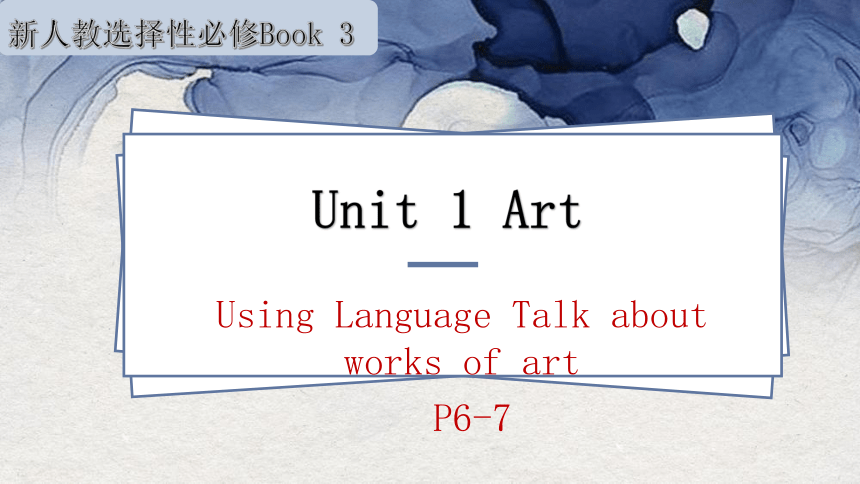 | |
| 格式 | pptx | ||
| 文件大小 | 9.1MB | ||
| 资源类型 | 教案 | ||
| 版本资源 | 人教版(2019) | ||
| 科目 | 英语 | ||
| 更新时间 | 2024-03-08 17:08:30 | ||
图片预览

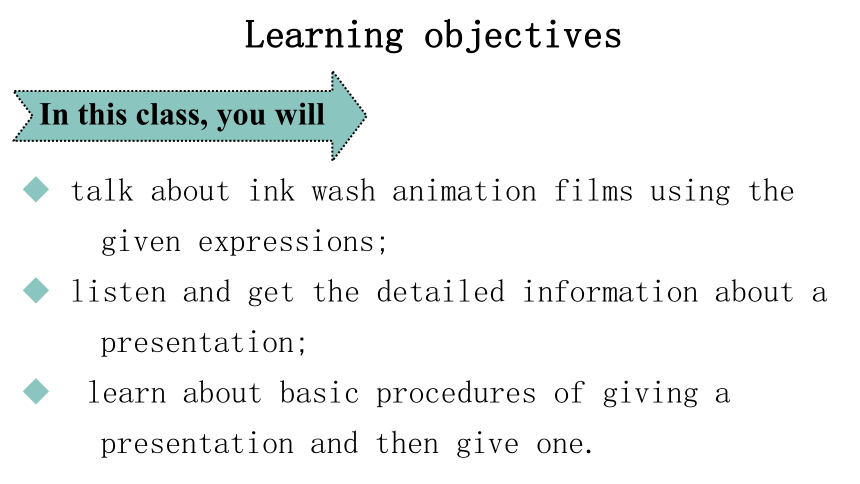


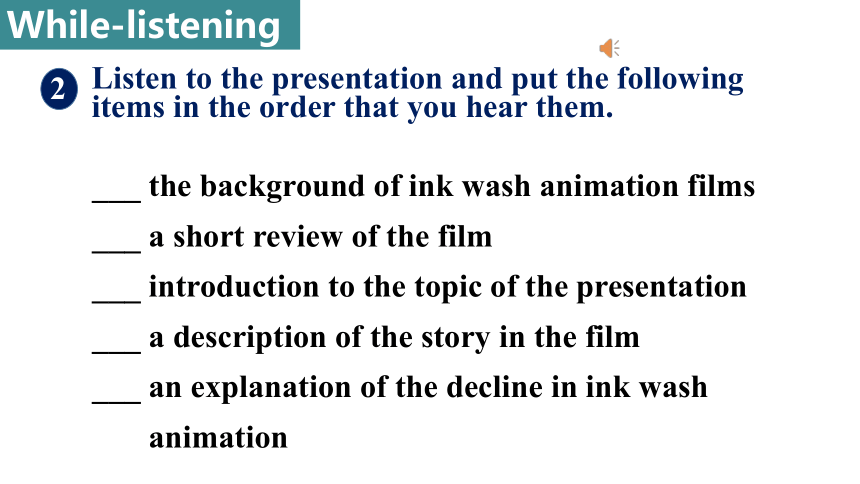
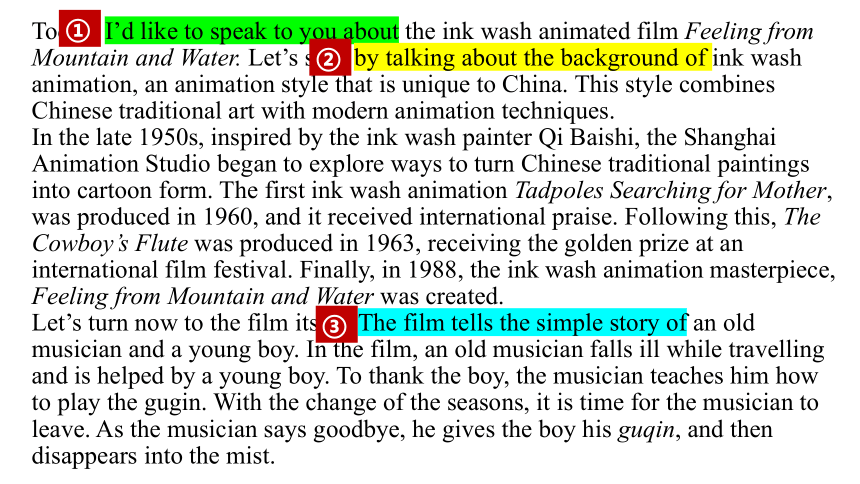
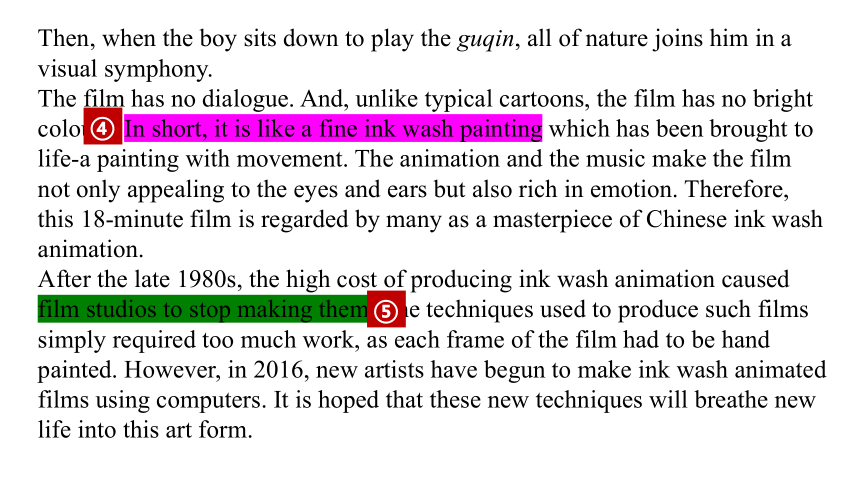
文档简介
(共19张PPT)
Using Language Talk about works of art
P6-7
新人教选择性必修Book 3
Unit 1 Art
Learning objectives
talk about ink wash animation films using the
given expressions;
listen and get the detailed information about a
presentation;
learn about basic procedures of giving a
presentation and then give one.
In this class, you will
Pre-listening
Do you know what is an ink wash animation film水墨动画电影
It is an animation style that is unique to China. It combines Chinese traditional art with modern animation techniques.
Tadpoles Searching for Mother
Bell on a Deer
Look at the following pictures and answer the questions. Use the words and phrases in the box to help you.
1. Have you seen any of them before
2. What do you know about them
1
ink wash animation film ink wash painting Qi Baishi
frame Tadpoles Searching for Mother
The Cowboy’s Flute Feeling from Mountain and Water
guqin symphony hand-painted
These pictures are representative of ink wash animation films.
Listen to the presentation and put the following
items in the order that you hear them.
___ the background of ink wash animation films
___ a short review of the film
___ introduction to the topic of the presentation
___ a description of the story in the film
___ an explanation of the decline in ink wash
animation
While-listening
2
Today, I’d like to speak to you about the ink wash animated film Feeling from Mountain and Water. Let’s start by talking about the background of ink wash animation, an animation style that is unique to China. This style combines Chinese traditional art with modern animation techniques.
In the late 1950s, inspired by the ink wash painter Qi Baishi, the Shanghai Animation Studio began to explore ways to turn Chinese traditional paintings into cartoon form. The first ink wash animation Tadpoles Searching for Mother, was produced in 1960, and it received international praise. Following this, The Cowboy’s Flute was produced in 1963, receiving the golden prize at an international film festival. Finally, in 1988, the ink wash animation masterpiece, Feeling from Mountain and Water was created.
Let’s turn now to the film itself. The film tells the simple story of an old musician and a young boy. In the film, an old musician falls ill while travelling and is helped by a young boy. To thank the boy, the musician teaches him how to play the gugin. With the change of the seasons, it is time for the musician to leave. As the musician says goodbye, he gives the boy his guqin, and then disappears into the mist.
①
②
③
Then, when the boy sits down to play the guqin, all of nature joins him in a visual symphony.
The film has no dialogue. And, unlike typical cartoons, the film has no bright colours. In short, it is like a fine ink wash painting which has been brought to life-a painting with movement. The animation and the music make the film not only appealing to the eyes and ears but also rich in emotion. Therefore, this 18-minute film is regarded by many as a masterpiece of Chinese ink wash animation.
After the late 1980s, the high cost of producing ink wash animation caused film studios to stop making them. The techniques used to produce such films simply required too much work, as each frame of the film had to be hand painted. However, in 2016, new artists have begun to make ink wash animated films using computers. It is hoped that these new techniques will breathe new life into this art form.
④
⑤
Listen to the presentation and put the following
items in the order that you hear them.
___ the background of ink wash animation films
___ a short review of the film
___ introduction to the topic of the presentation
___ a description of the story in the film
___ an explanation of the decline in ink wash
animation
While-listening
2
4
1
3
5
2
Listen again and answer the questions.
3
1. Which film does the speaker mainly talk about
2. When were the three ink wash animation films
produced
3. Why is the film regarded as a masterpiece of
Chinese ink wash animation
4. What is the speaker’s attitude towards the ink
wash animation style
5. How do you feel about this kind of film
1. Which film does the speaker mainly talk about
ink wash animation film
2. When were the three ink wash animation films produced
1960 Tadpoles Searching for Mother
1963 The Cowboy’s Flute
1988 Feeling from Mountain and Water
3. Why is the film regarded as a masterpiece of Chinese ink wash
animation
4. What is the speaker’s attitude towards the ink wash animation style
The film is regarded as a masterpiece because it is
like a fine ink wash painting brought to life.
The speaker’s attitude towards the ink wash animation style is positive, hoping that new technology will breathe new life into it.
5. How do you feel about this kind of film
I think this kind of film is beautiful and magical to watch. It makes me feel like I am inside a painting.
Listen for the signpost markers.
4
What are signpost markers
Signpost markers are phrases and expressions that are used to tell a listener what is going to be talked about next. Speakers use signpost markers when they want to introduce a new topic, to start a new point, to give an example, to summarize, etc. By listening to signposts, you will be able to follow what is being said.
Listen again and tick the signpost words you hear.
Making a presentation
Introducing the topic I’m glad to have this opportunity to …
Today, I’d like to talk/speak (to you)
about …
My topic today is …
I’d like to share some thoughts on …
Starting a point Let me/Let’s start by …
First, let me tell you about …
I’ve divided my topic into … parts: …
Let’s turn now to the …
√
√
√
Listen again and tick the signpost words you hear.
Making a presentation
Giving an example For instance, …
For example, …
Take ... for example, …
Let me illustrate, …
To illustrate, …
Let me give you an example, …
Summarising the points In conclusion, …
To conclude, …
In short, …
To sum up, …
All in all, …
In brief, …
√
Today, I’d like to speak to you about the ink wash animated film Feeling from Mountain and Water. Let’s start by talking about the background of ink wash animation, an animation style that is unique to China. This style combines Chinese traditional art with modern animation techniques.
In the late 1950s, inspired by the ink wash painter Qi Baishi, the Shanghai Animation Studio began to explore ways to turn Chinese traditional paintings into cartoon form. The first ink wash animation Tadpoles Searching for Mother, was produced in 1960, and it received international praise. Following this, The Cowboy’s Flute was produced in 1963, receiving the golden prize at an international film festival. Finally, in 1988, the ink wash animation masterpiece, Feeling from Mountain and Water was created.
Let’s turn now to the film itself. The film tells the simple story of an old musician and a young boy. In the film, an old musician falls ill while travelling and is helped by a young boy. To thank the boy, the musician teaches him how to play the gugin. With the change of the seasons, it is time for the musician to leave. As the musician says goodbye, he gives the boy his guqin, and then disappears into the mist.
Listening text
Listening text
Then, when the boy sits down to play the guqin, all of nature joins him in a visual symphony.
The film has no dialogue. And, unlike typical cartoons, the film has no bright colours. In short, it is like a fine ink wash painting which has been brought to life-a painting with movement. The animation and the music make the film not only appealing to the eyes and ears but also rich in emotion. Therefore, this 18-minute film is regarded by many as a masterpiece of Chinese ink wash animation.
After the late 1980s, the high cost of producing ink wash animation caused film studios to stop making them. The techniques used to produce such films simply required too much work, as each frame of the film had to be hand painted. However, in 2016, new artists have begun to make ink wash animated films using computers. It is hoped that these new techniques will breathe new life into this art form.
Post-listening
Group work. Choose a work of art you like and
make a presentation about it.
5
Introduction Welcome the
audience:
Introduce the
subject:
Main body Background of the work of art
Description of the work of art
Review of the work of art
Conclusion
Good morning, everybody. Welcome to our presentation.
I’m glad to have this chance to ...
First, let me tell you about the background to ...
All in all / In short, ...
The work earned great acclaim because ...
This is an art work of ...
Homework
完成课本p7练习
Using Language Talk about works of art
P6-7
新人教选择性必修Book 3
Unit 1 Art
Learning objectives
talk about ink wash animation films using the
given expressions;
listen and get the detailed information about a
presentation;
learn about basic procedures of giving a
presentation and then give one.
In this class, you will
Pre-listening
Do you know what is an ink wash animation film水墨动画电影
It is an animation style that is unique to China. It combines Chinese traditional art with modern animation techniques.
Tadpoles Searching for Mother
Bell on a Deer
Look at the following pictures and answer the questions. Use the words and phrases in the box to help you.
1. Have you seen any of them before
2. What do you know about them
1
ink wash animation film ink wash painting Qi Baishi
frame Tadpoles Searching for Mother
The Cowboy’s Flute Feeling from Mountain and Water
guqin symphony hand-painted
These pictures are representative of ink wash animation films.
Listen to the presentation and put the following
items in the order that you hear them.
___ the background of ink wash animation films
___ a short review of the film
___ introduction to the topic of the presentation
___ a description of the story in the film
___ an explanation of the decline in ink wash
animation
While-listening
2
Today, I’d like to speak to you about the ink wash animated film Feeling from Mountain and Water. Let’s start by talking about the background of ink wash animation, an animation style that is unique to China. This style combines Chinese traditional art with modern animation techniques.
In the late 1950s, inspired by the ink wash painter Qi Baishi, the Shanghai Animation Studio began to explore ways to turn Chinese traditional paintings into cartoon form. The first ink wash animation Tadpoles Searching for Mother, was produced in 1960, and it received international praise. Following this, The Cowboy’s Flute was produced in 1963, receiving the golden prize at an international film festival. Finally, in 1988, the ink wash animation masterpiece, Feeling from Mountain and Water was created.
Let’s turn now to the film itself. The film tells the simple story of an old musician and a young boy. In the film, an old musician falls ill while travelling and is helped by a young boy. To thank the boy, the musician teaches him how to play the gugin. With the change of the seasons, it is time for the musician to leave. As the musician says goodbye, he gives the boy his guqin, and then disappears into the mist.
①
②
③
Then, when the boy sits down to play the guqin, all of nature joins him in a visual symphony.
The film has no dialogue. And, unlike typical cartoons, the film has no bright colours. In short, it is like a fine ink wash painting which has been brought to life-a painting with movement. The animation and the music make the film not only appealing to the eyes and ears but also rich in emotion. Therefore, this 18-minute film is regarded by many as a masterpiece of Chinese ink wash animation.
After the late 1980s, the high cost of producing ink wash animation caused film studios to stop making them. The techniques used to produce such films simply required too much work, as each frame of the film had to be hand painted. However, in 2016, new artists have begun to make ink wash animated films using computers. It is hoped that these new techniques will breathe new life into this art form.
④
⑤
Listen to the presentation and put the following
items in the order that you hear them.
___ the background of ink wash animation films
___ a short review of the film
___ introduction to the topic of the presentation
___ a description of the story in the film
___ an explanation of the decline in ink wash
animation
While-listening
2
4
1
3
5
2
Listen again and answer the questions.
3
1. Which film does the speaker mainly talk about
2. When were the three ink wash animation films
produced
3. Why is the film regarded as a masterpiece of
Chinese ink wash animation
4. What is the speaker’s attitude towards the ink
wash animation style
5. How do you feel about this kind of film
1. Which film does the speaker mainly talk about
ink wash animation film
2. When were the three ink wash animation films produced
1960 Tadpoles Searching for Mother
1963 The Cowboy’s Flute
1988 Feeling from Mountain and Water
3. Why is the film regarded as a masterpiece of Chinese ink wash
animation
4. What is the speaker’s attitude towards the ink wash animation style
The film is regarded as a masterpiece because it is
like a fine ink wash painting brought to life.
The speaker’s attitude towards the ink wash animation style is positive, hoping that new technology will breathe new life into it.
5. How do you feel about this kind of film
I think this kind of film is beautiful and magical to watch. It makes me feel like I am inside a painting.
Listen for the signpost markers.
4
What are signpost markers
Signpost markers are phrases and expressions that are used to tell a listener what is going to be talked about next. Speakers use signpost markers when they want to introduce a new topic, to start a new point, to give an example, to summarize, etc. By listening to signposts, you will be able to follow what is being said.
Listen again and tick the signpost words you hear.
Making a presentation
Introducing the topic I’m glad to have this opportunity to …
Today, I’d like to talk/speak (to you)
about …
My topic today is …
I’d like to share some thoughts on …
Starting a point Let me/Let’s start by …
First, let me tell you about …
I’ve divided my topic into … parts: …
Let’s turn now to the …
√
√
√
Listen again and tick the signpost words you hear.
Making a presentation
Giving an example For instance, …
For example, …
Take ... for example, …
Let me illustrate, …
To illustrate, …
Let me give you an example, …
Summarising the points In conclusion, …
To conclude, …
In short, …
To sum up, …
All in all, …
In brief, …
√
Today, I’d like to speak to you about the ink wash animated film Feeling from Mountain and Water. Let’s start by talking about the background of ink wash animation, an animation style that is unique to China. This style combines Chinese traditional art with modern animation techniques.
In the late 1950s, inspired by the ink wash painter Qi Baishi, the Shanghai Animation Studio began to explore ways to turn Chinese traditional paintings into cartoon form. The first ink wash animation Tadpoles Searching for Mother, was produced in 1960, and it received international praise. Following this, The Cowboy’s Flute was produced in 1963, receiving the golden prize at an international film festival. Finally, in 1988, the ink wash animation masterpiece, Feeling from Mountain and Water was created.
Let’s turn now to the film itself. The film tells the simple story of an old musician and a young boy. In the film, an old musician falls ill while travelling and is helped by a young boy. To thank the boy, the musician teaches him how to play the gugin. With the change of the seasons, it is time for the musician to leave. As the musician says goodbye, he gives the boy his guqin, and then disappears into the mist.
Listening text
Listening text
Then, when the boy sits down to play the guqin, all of nature joins him in a visual symphony.
The film has no dialogue. And, unlike typical cartoons, the film has no bright colours. In short, it is like a fine ink wash painting which has been brought to life-a painting with movement. The animation and the music make the film not only appealing to the eyes and ears but also rich in emotion. Therefore, this 18-minute film is regarded by many as a masterpiece of Chinese ink wash animation.
After the late 1980s, the high cost of producing ink wash animation caused film studios to stop making them. The techniques used to produce such films simply required too much work, as each frame of the film had to be hand painted. However, in 2016, new artists have begun to make ink wash animated films using computers. It is hoped that these new techniques will breathe new life into this art form.
Post-listening
Group work. Choose a work of art you like and
make a presentation about it.
5
Introduction Welcome the
audience:
Introduce the
subject:
Main body Background of the work of art
Description of the work of art
Review of the work of art
Conclusion
Good morning, everybody. Welcome to our presentation.
I’m glad to have this chance to ...
First, let me tell you about the background to ...
All in all / In short, ...
The work earned great acclaim because ...
This is an art work of ...
Homework
完成课本p7练习
